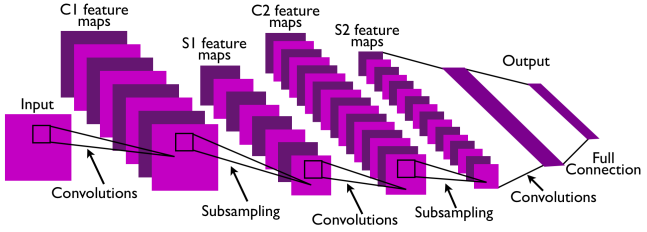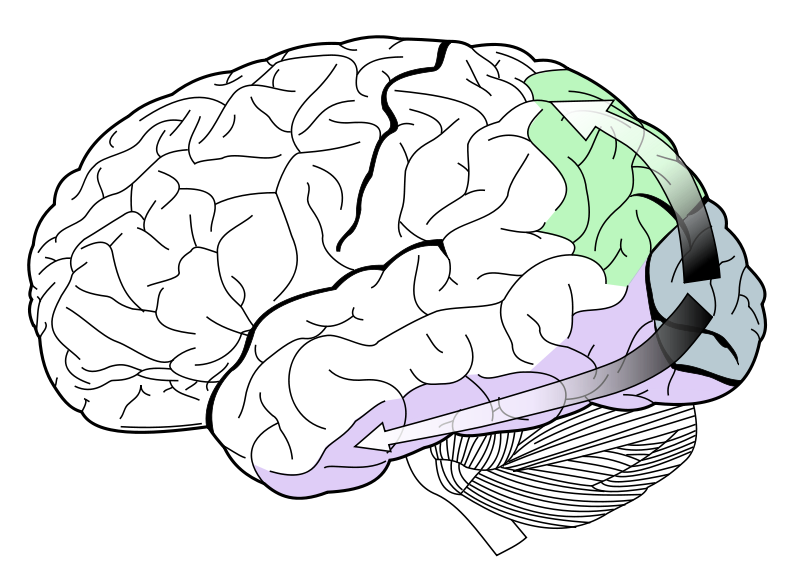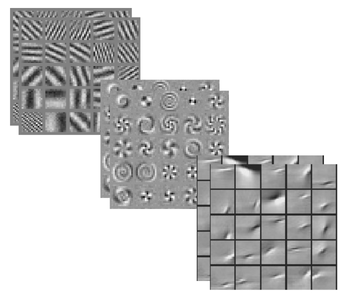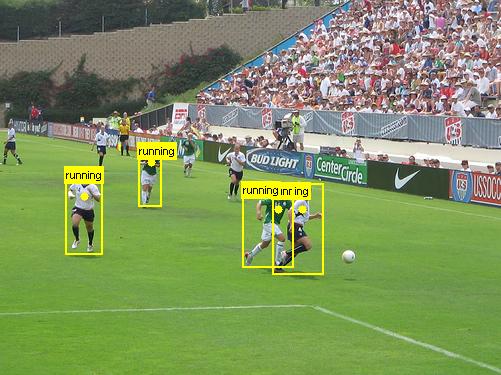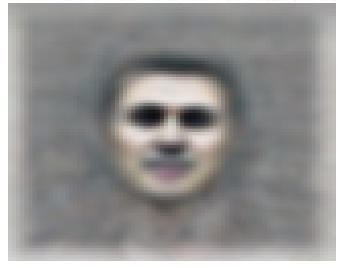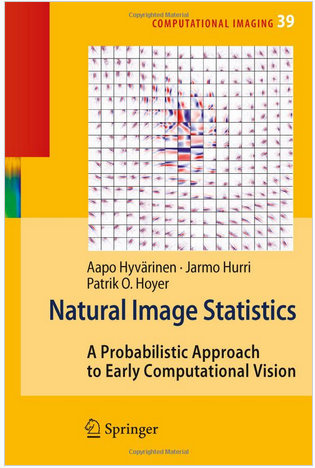| Learning about images |
Suggested readings
-
[Background]
Some Informational Aspects Of Visual Perception. F. Attneave. Psychological Review 1954. [pdf]
-
[Background]
Possible Principles Underlying the Transformations of Sensory Messages. H.B. Barlow. Sensory communication 1961. [pdf]
-
[Background] Emergence of Simple-Cell Receptive Field Properties by Learning a Sparse Code for Natural Images. B.A. Olshausen, D.J. Field. Nature, 1996. [pdf]
-
[Background] The `Independent Components' of Natural Scenes are Edge Filters. T. Bell, T. Sejnowski. Vis. Res. 1997 [pdf]
-
[Background]
Independent Component Analysis: Algorithms and Applications. A. Hyvarinen, E. Oja. Neural Computation 2000. [pdf]
-
[Background] Sparse Coding. P. Foldiak, D. Endres. Scholarpedia. [link]
-
Do We Know What the Early Visual System Does? M. Carrandini, et al. The Journal of Neuroscience 2005. [pdf].
-
Slow Feature Analysis: Unsupervised Learning of Invariances. L. Wiskott, T. Sejnowski. Neural Computation 2002. [pdf]
-
Natural Images, Gaussian Mixtures and Dead Leaves. D. Zoran, Y. Weiss. NIPS 2012 [pdf]
|
|
Date
|
Topic
|
Readings
|
Materials
|
|
Jan. 22
|
Lecture: Introduction
|
|
notes
|
|
Jan. 25
|
Lecture: Review of basic statistics, linear algebra
|
|
notes
Python logsumexp implementation.
|
|
Jan. 29
|
Lecture: Fourier representation and frequency analysis
|
- useful reading: textbook chapters 2, 20.
|
notes
|
|
Jan. 31
|
Lecture: Fourier part II
|
|
notes
|
|
Feb. 5
|
Lecture: Fourier part III, Preprocessing, PCA, whitening
|
- Possible Principles Underlying the Transformations of Sensory Messages. H.B. Barlow. [pdf]
- Interesting, not required: Some Informational Aspects Of Visual Perception. F. Attneave. [pdf]
- Useful background on PCA: textbook, sections 5.1 - 5.9.2.
|
assignment 1 (worth 10%)
notes
|
|
Feb. 8
|
Lecture: PCA and Fourier representation,
some biological aspects of image processing
|
- Textbook chapter 3.
- Sparse Coding. P. Foldiak, D. Endres. Scholarpedia. [link]
|
notes
|
|
Feb. 12
|
Lecture: ICA, sparse coding
|
- useful background reading:
The `Independent Components' of Natural Scenes are Edge Filters. T. Bell, T. Sejnowski. Vis. Res. 1997 [pdf]
|
assignment 1 due at the beginning of class
notes
|
|
Feb. 15
|
Lecture: Feature Learning II
|
- read the presentation guidelines
-
Emergence of Simple-Cell Receptive Field Properties by Learning a Sparse Code for Natural Images. B.A. Olshausen, D.J. Field. Nature, 1996. [pdf]
|
notes
|
|
Feb. 19
|
Lecture: Feature Learning III
review of assignment 1
Presentations/Discussion
|
- An analysis of single-layer networks in unsupervised feature learning. A. Coates, H. Lee, A. Y. Ng. AISTATS 2011. [pdf] (Salah R.)
|
assignment 2 (worth 10%)
A1 solution Q2
A1 solution Q4
notes
|
|
Feb. 22
|
Lecture: More on kmeans, energy based models
Presentations/Discussion
|
-
Building high-level features using large scale unsupervised learning. Q. Le, M.A. Ranzato, R. Monga, M. Devin, K. Chen, G. Corrado, J. Dean, A. Ng. ICML 2012. [pdf] (Pierre Luc C.)
-
ImageNet Classification with Deep Convolutional Neural Networks. A. Krizhevsky, I. Sutskever, G.E. Hinton. NIPS 2012. [pdf]
|
notes
|
|
Feb. 26
|
Lecture: Restricted Boltmann Machines
Presentations/Discussion
|
-
Noise-contrastive estimation: A new estimation principle for unnormalized statistical models. M. Gutmann, A. Hyvarinen. AISTATS 2010. [pdf] (Sebastien J.)
- Sparse filtering. J. Ngiam, et. al. NIPS 2011. [pdf] (Antoine M.)
|
assignment 2 due at the beginning of class
notes
|
|
Mar. 1
|
Lecture: more on RBMs
MRF models
Presentations/Discussion
|
-
Fields of Experts. S. Roth, M. Black. IJCV 2007. [pdf] (Francis Q. L.)
-
Deconvolutional Networks. M. Zeiler, D. Krishnan, G. Taylor, R. Fergus. CVPR 2010. [pdf] (Vincent A.)
|
|
| Learning about motion, geometry and invariance |
Suggested readings
-
[Background] Spatiotemporal energy models for the perception of motion. E.H. Adelson and J.R. Bergen. Journal Opt. Soc. Am. [pdf]
-
[Background] Neural Encoding of Binocular Disparity: Energy Models, Position Shifts and Phase Shifts. D. Fleet, H. Wagner, D. Heeger. Vision Research 1996. [pdf]
-
[Background] Learning Invariance from Transformation Sequences. P. Foldiak. Neural Computation 1991. [pdf].
-
Topographic Independent Component Analysis. A. Hyvarinen, P.O. Hoyer, M. Inki. Neural Computation 2001. [pdf]
-
Unsupervised learning of image transformations. R. Memisevic and G.E. Hinton. CVPR 2007. [pdf]
-
A multi-layer sparse coding network learns contour coding from natural images. P.O. Hoyer and A. Hyvarinen. Vision Research 2002. [ps]
-
Emergence of Phase- and Shift-Invariant Features by Decomposition of Natural Images into Independent Feature Subspaces. A. Hyvarinen, P. Hoyer. Neural Computation 2000. [pdf]
-
Dynamic Scene Understanding: The Role of Orientation Features in Space and Time in Scene Classification. K.G. Derpanis, M. Lecce, K. Daniildis, R.P. Wildes. CVPR 2012. [pdf]
-
Action spotting and recognition based on a spatiotemporal orientation analysis. K.G. Derpanis, M. Sizintsev, K. Cannons, R.P. Wildes. PAMI 2013. [pdf]
|
|
Date
|
Topic
|
Readings
|
Materials
|
|
Mar. 12
|
review of assignment 2
brief review of squaring and complex cells
|
Spatiotemporal energy models for the perception of motion. E.H. Adelson and J.R. Bergen. Journal Opt. Soc. Am. [pdf]
|
assignment 3 (worth 10%)
A2 solution Q3 (online kmeans)
A2 solution Q3 (kmeans on cifar)
|
|
Mar. 15
|
Lecture: Relations, gating and complex cells I
|
Learning to relate images. Roland Memisevic TPAMI 2013 [pdf]
|
notes
|
|
Mar. 19
|
Lecture: Relations, gating and complex cells II
|
|
assignment 3 due at the beginning of class
|
|
Mar. 22
|
Presentations/Discussion
Energy models on single images
|
-
What is the Best Multi-Stage Architecture for Object Recognition?
K. Jarrett, K. Kavukcuoglu, M.A. Ranzato, Y. LeCun. CVPR 2009. [pdf] (Nicholas L.)
-
On Random Weights and Unsupervised Feature Learning. A Saxe, et al. ICML 2011. [pdf] (Pierre Luc C.)
|
A3 solution Q3
|
|
Mar. 26
|
Discussion of assignment 3 Q3
Lecture: Relations, gating and complex cells III
|
|
The slides from my IPAM tutorial:
part 1 and
part 2.
|
|
Apr. 2
|
Discussion of assignment 3 Q1/Q2
Presentations/Discussion
Energy models on single images II
|
-
How to generate realistic images using gated MRF's. M.A. Ranzato, V. Mnih, G. Hinton. NIPS 2010. [pdf] (Francis Q.L.)
|
|
|
Apr. 5
|
Presentations/Discussion
Motion features and activity recognition
|
-
Convolutional Learning of Spatio-temporal Features. G. Taylor, R. Fergus, Y. LeCun and C. Bregler. ECCV, 2010. [pdf] (Xavier B.)
-
Learning hierarchical invariant spatio-temporal features for action recognition with independent subspace analysis. Q.V. Le, W.Y. Zou, S.Y. Yeung, A.Y. Ng. CVPR 2011 [pdf] (Antoine M.)
|
|
|
Apr. 9
|
Presentations/Discussion
Learning about images from movies
|
-
Learning Intermediate-Level Representations of Form and Motion from Natural Movies. C.F. Cadieu, B.A. Olshausen. Neural Computation 2012. [pdf] (Xavier B.)
-
Deep Learning of Invariant Features via Simulated Fixations in Video. W. Zou, A. Ng, S. Zhu, K. Yu. NIPS 2012. (Sebastien J.)
[pdf]
|
|
|
Apr. 12
|
Presentations/Discussion
Fixations
Group structure and topography
|
-
Topographic Independent Component Analysis. A. Hyvarinen, P.O. Hoyer, M. Inki. Neural Computation 2001. [pdf]
-
Learning Invariant Features through Topographic Filter Maps. K. Kavukcuoglu, M.A. Ranzato, R. Fergus, Y. LeCun. CVPR 2009. [pdf] (Magatte D.)
-
Learning to combine foveal glimpses with a third-order Boltzmann machine. H. Larochelle and G. Hinton. NIPS 2010. [pdf] (Vincent A.)
|
|
| Learning about shape, learning where to look, miscellaneous. |
Suggested readings
-
A Model of Saliency-Based Visual Attention for Rapid Scene Analysis. L. Itti, C. Koch, E. Niebur. PAMI 1998. [pdf]
- Searching for objects driven by context. Alexe, et al. NIPS 2012 [pdf]
-
Convolutional Deep Belief Networks for Scalable Unsupervised Learning of Hierarchical Representations. H. Lee, R. Grosse, R. Ranganath, and A. Y. Ng. ICML 2009. [pdf]
-
Learning where to attend with deep architectures for image tracking. M. Denil, L. Bazzani, H. Larochelle, N. de Freitas. Neural Computation 2012. [pdf]
-
Factored Conditional Restricted Boltzmann Machines for Modeling Motion Style. G. Taylor, G. Hinton. ICML 2009. [pdf]
-
Learning a Generative Model of Images by Factoring Appearance and Shape. N. Le Roux, N. Heess, J. Shotton, J. Winn. Neural Computation 2012. [pdf]
|
|
Date
|
Topic
|
Readings
|
Materials
|
|
Apr. 16
|
Presentations/Discussion
Miscellaneous topics
|
- WSABIE: Scaling Up To Large Vocabulary Image Annotation. J. Weston, et al. IJCAI [pdf] (Salah R.)
- The Shape Boltzmann Machine: a Strong Model of Object Shape. S.M.A.Eslami, N.Hess, J.Winn. CVPR 2012. [pdf] (Nicholas L.)
- Emergence of Object-Selective Features in Unsupervised Feature Learning. A. Coates et al. NIPS 2012. [pdf] (Magatte D.)
|
|
|
Apr. 19
|
Wrap-up
Final Project Presentations and Discussions
|
- Transforming Auto-encoders. G. Hinton, A. Krizhevsky, S. Wang. ICANN 2011. [pdf]
- Project Nicholas L.
- Project Francis Q. L.
- Project Antoine M.
|
|
|
Apr. 22
|
Project office hour
|
|
|
|
Apr. 23
|
Final Project Presentations and Discussions
|
- Project Sebastien J.
- Project Xavier B.
- Project Vincent A.B.
- Project Pierre Luc C.
- Project Salah R.
- Project Magatte D.
|
|
|
Apr. 30
|
|
Final Projects Due
|
|
